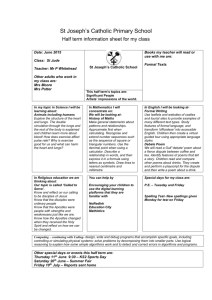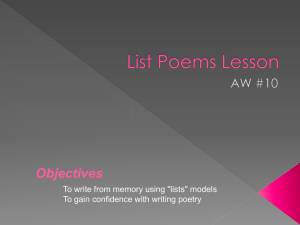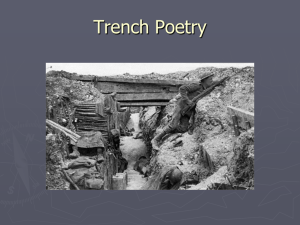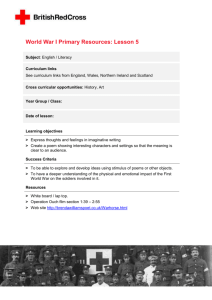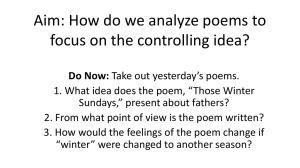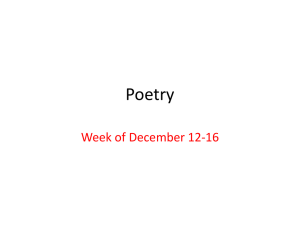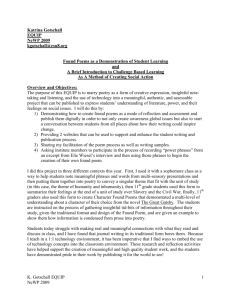Found Poems
advertisement
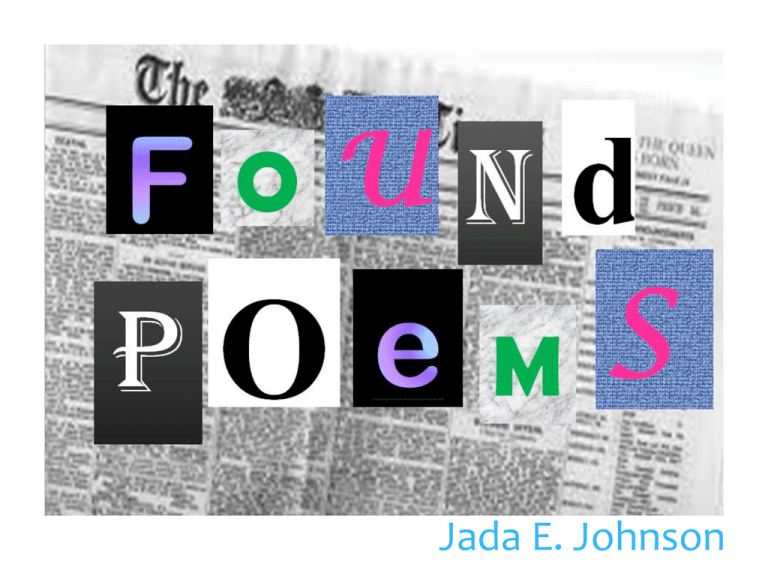
Jada E. Johnson Found Poems A type of poetry created by taking words, phrases, and sometimes whole passages from other sources and reframing them as poetry by making changes in spacing and lines, or by altering the text by additions and deletions. Students use the authors words to create their own new text. News Paper Blackout Poems By: Austin Kleon Emotionally – Life is hard. When things are stressful at home or outside of school, we, as teachers, are sometimes less patient, or we are more critical of something or someone, or we shut down. The same thing happens to children, only they do not always have the coping mechanisms that adults have (exercise, counseling, peer support). Therefore, when children (young, middle and old) experience stress, they can sometimes appear less attentive, or show other signs of stress that keep them from focusing on that all important “slope”. I had a desk in my room that was for “time out”, not just for the “go to time out because of your behavior”, but ‘sometimes we need a little space and that is a place that is safe’. If a student asked to go there I would let them. Once class got started I could go over and find out what was going on or ask if they wanted to go to the guidance office. The best advice here is that when students show some emotional changes 1) don’t take it personally, and 2) let the guidance counselor know. Emotionally – Life is hard. When things are stressful at home or outside of school,we, Found Poem by Jada Johnson as teachers,aresometimeslesspatient,or we are morecritical of something or someone, or we shut down. The same thing happens to children, only they do not always have the coping mechanisms that adults have (exercise, counseling, peer support). Therefore, when children (young, middle and old)experience stress, they can sometimesappear less attentive, orshow other signs of stress thatkeep themfrom focusingon that all important “slope”. I had a desk in my room that was for“time out”, notjust for the “go to time out because of your behavior”, but ‘sometimeswe need a little space and that is a place that is safe’. If a student asked to go there Iwould let them. Once class got started I couldgo over and find out what was going onor ask if they wanted to. go to the guidance office. The best advicehere is that whentudents show some emotional changes 1) don’t take it personally, and 2) let theguidance counselor know. Using a passage from Nancy Ruppert’s ‘Differentiation for the 21st Century’ Found Poems in the Classroom Poems need to retain the meaning of the original text. Students must carefully consider the author’s purpose, syntax, and specific word choices. This encourages students to discover how authors use specific words and images to capture the essence of their writing and the information they would like to convey. Found Poems in the Classroom Supports comprehension after reading Used as a review of vocabulary and key terms Gives literary experience in classes outside of language arts Encourages the use of figurative and descriptive language Students become more insightful readers and develop creativity in thinking and writing Creating a Found Poem As they read through the passage circle, highlight, or list the strongest words in the passage. Strike through repetitive or unnecessary words. Pay special attention to the author’s original meaning, word choice, word order, and phrases that require emphasis or reflect back to information presented in the content lesson. Emphasize purposeful reading first, otherwise students will focus on the technical aspects of creating a poem instead. Creating a Found Poem Start poems with a strong word or phrase. As much as possible, honor the author’s original word order. Think about which phrases require emphasis. Edit the poem for verb tense and add words to maintain grammatical sense (keep additions to a minimum). Title the work and write a final draft to present or turn in. Include a citation of the text used. References Fisher, D., Brozo, W. G., Frey, N., & Ivey, G. (2011). 50 instructional routines to develop content literacy. (2 ed., pp. 31-33). Boston: Pearson. Jenkins, M. (2000). Teach yourself 101 key ideas: Genetics. (1 ed., pp. 1-101). Chicago: NTC/Contemporary Publishing. Directions (Printed Out) 1. As you read through your passage circle or list the strongest words in the passage. Strike through any repetitive or unnecessary words. 2. Pay special attention to: words and vocabulary that we have covered in class, causes, & symptoms/ problems associated with condition. 3. Start your poem with a strong word or phrase. As much as possible honor the author’s original word order. Think about which phrases require emphasis. 4. Edit your poem for verb tense and add words to maintain grammatical sense (keep additions to a minimum). 5. Title your work and write a final draft to present to the class.


